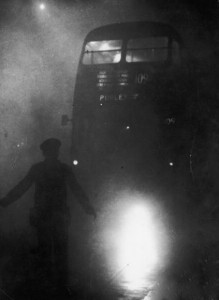64 Years after the London Fog Disaster of 1952 and 60 Years after the UK Clean Air Act of 1956
The recent news from London and the UK is that air pollution is causing 40,000 early deaths across the country every year, 10,000 in London alone; air pollution was called a “public health emergency” by a cross-party committee of MPs; the recalcitrant UK government is facing a new legal challenge by ClientEarth over the adequacy of its plans to tackle the issue, having already lost a previous case in 2015; and recently published research shows many schools in London are in areas exceeding safe legal pollution levels.
Did we learn nothing from the environmental disaster known as the London Fog of 1952?
The most striking fact about the London Fog of 1952 was not that within several weeks at least 4,000 people died from it, and possibly more than 12,000, but that at the time no one seemed to recognize it was a disaster.
After all, London had been notorious for its fog for a very long time. Romantic notions were attached to the fog, with events in many a thriller, period novel, and film set amidst fog-bound London. For the residents of London, the fog was a frequent, if unwelcome, guest who was becoming a bit of a nuisance.
But cheap bituminous coal increasingly was used to heat the homes of Londoners. While the coal made life easy, the soot from those individual home fires combined with water in the air to form smog and people did not imagine that their home fires were putting themselves and their neighbors at risk.
And in December 1952, aggravating the thick, soot-laden air from the city’s industries and household fires was a temperature inversion that deepened the impacts. The combination was insidious.
Everyone knew, of course, that for four days the fog was so thick that traveling throughout the city was almost impossible. For five days, the air over the city was black and yellow, day became night, and everyone and everything was covered with soot.
Flares were placed at intersections for the vehicles still on the streets. People groped along buildings, stumbled over curbs and each other, and when they arrived home found they were covered with soot.
The famous red double-decker buses inched along, bumper-to-bumper, with conductors leading the way by walking in front with flares, shouting directions. Ambulances traveled the same way.
The fog followed people inside, through open doors, down chimneys, even through cracks in walls, floors, and windows. A performance of Verdi’s La Traviata was cancelled after the first act because fog inside the theater made the stage invisible.
Hospitals began to fill up. With so many patients needing assistance, the ambulances began to carry several on each trip to the hospital. On one trip, an ambulance that had been dispatched to carry four patients to a hospital ended up taking them all to the mortuary instead.
Those who suffered were the most vulnerable —the very young whose physical strength and defenses were as yet not fully formed, and the old whose biological systems were already breaking down. The particulate matter and other contaminants that they inhaled simply overpowered their respiratory systems.
Only months after the fog lifted did it become clear, through medical reports and news coverage, that thousands had died in a few short weeks as a result of those traditional home fires and the carbon they belched out. People finally came to realize that their pokeable home fires were killers.
That recognition, bolstered by action from citizen activists, pressured the government into appointing a committee to investigate. That investigation, again coupled with pressure from civic groups, led to the enactment of the Clear Air Act in July 1956.
The Clean Air Act did indeed clean up the air of London and other urban areas of the household pollution from coal fires. But now other forms of fossil fuels are again polluting the air, this time from the vehicles that most rely on to get around. Like the individual home coal fires, each car, van and truck is fast becoming a killing machine.
It’s time for a new Clean Air Act. And as before, the struggle will have to begin with citizen activism.
Sources:
Adapted from “London Fog 1952,” in Robert Emmet Hernan, This Borrowed Earth: Lessons From the 15 Worst Environmental Disasters Around the World (published in English by Palgrave Macmillan, 2010, and in Chinese by China Machine Press, 2011. www.environmentaldisasters.info/environmentaldisasters.info/Contents.html
“Life before the Clean Air Act – your memories and pictures,” The Guardian (5 July 2016). www.theguardian.com/environment/2016/jul/05/life-before-the-clean-air-act-your-memories-and-pictures
Damian Carrington, “Sadiq Khan unveils plans for extra charge on London’s most polluting cars,” The Guardian (5 July 2016). www.theguardian.com/environment/2016/jul/05/sadiq-khan-unveils-plans-for-extra-charge-on-londons-most-polluting-cars



No comments yet, add your own below